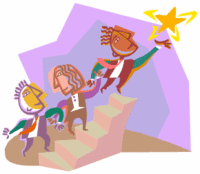Personality Styles and Joint Ventures
 A client of mine who owned a chain of restaurants radically improved his business when we tested his employees for the personality styles and re-organized the business. We all have characteristics of all the four major personality styles, however one is normally dominant. In business, it’s important to acknowledge our strengths and leverage them, and to find others to supplement our weaknesses. There’s no right or wrong character type. Here’s a quick overview.
A client of mine who owned a chain of restaurants radically improved his business when we tested his employees for the personality styles and re-organized the business. We all have characteristics of all the four major personality styles, however one is normally dominant. In business, it’s important to acknowledge our strengths and leverage them, and to find others to supplement our weaknesses. There’s no right or wrong character type. Here’s a quick overview. The High D – Dominant style (minority of people, hardest to find) is bottom-line and results oriented, impatient, sometimes tactless, driven and extroverted, with weaknesses in details. Major fear: being taken advantage of / ripped off. Good closers, great pioneers. Need the numbers and systems guys.
The High I – Influencing style is an extrovert, “party animal”, great at meeting people and starting relationships, popular, good opener, weakness is details and time management. Major fear: being embarrassed in public. Needs closers and numbers guys.
The High C – Cautious style is introverted, loves details, numbers and systems more than people, excellent numbers guys and accountants, computer experts, analyzers. Weakness is over analysis; fear is criticism of their work. Needs the extravert's and the drivers.
The High S – Steady style (majority of people) is an introvert, loyal, team player, family type, great systems and support person, needs security and long term relationships, fears risk, conflict and change. Needs others to make things happen and to create change and to take unpopular action when necessary.
This is a simplistic approach, but understanding our strengths and weaknesses and allowing people to do what they’re good at, while avoiding tasks that they’re weak at, is simply smart business sense. For technical sales we use High C’s and S’s. Ideal salespeople are normally High D’s with secondary I’s. One wouldn’t an accountant who is a High D, or a High S to launch a new business. You don’t want a High C to be the host at a cocktail party and we don’t want two High I’s behind a reception desk because they’ll talk all day!
Using personality style analysis has helped many of my clients to be better entrepreneurs and hire the appropriate people. Self knowledge is essential to success. I use the DISC style analysis – there are many others available, including the excellent Myers-Briggs Type Indicator. Click here for more information.
Sales Tip
Selling to High D’s: Talk results and ROI and close early and hard.
Selling to High I’s: Build relationship, have fun and close early.
Selling to High C’s: Provide copious details and proof and take time to close.
Selling to High S’s: Prove that the support and relationships will be in place long after the sale is made and close slowly.
Management Tip
Managing High D’s: Give them lots of control and clear objectives and do what you say you will do.
Managing High I’s: Reward them publicly, make them look good and watch their time allocation.
Managing High C’s: Be specific, don’t rush them, and compliment their work (catch them doing something right), set time goals.
Managing High S’s: Make changes slowly, provide lots of security, share long-term plans.
Robin J. Elliott www.DollarMakers.com Join the Joint Venture Eagles.
Robin J. Elliott has been officially included inthe International Who's Who of Entrepreneurs in 2002 and has been nominated as a candidate for inclusion in the 2004-2005 edition of the International Who's Who of Professionals.
Robin J. Elliott has been officially included inthe International Who's Who of Entrepreneurs in 2002 and has been nominated as a candidate for inclusion in the 2004-2005 edition of the International Who's Who of Professionals.











